AUDI S3 2010 Owners Manual
Manufacturer: AUDI, Model Year: 2010, Model line: S3, Model: AUDI S3 2010Pages: 320, PDF Size: 75.34 MB
Page 221 of 320
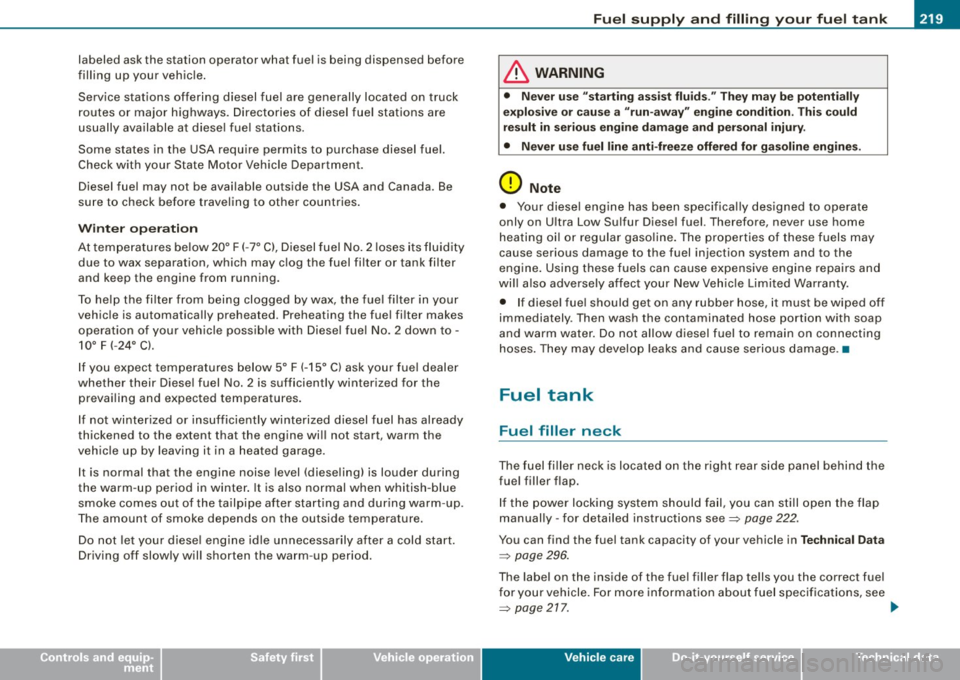
•
labeled ask the station operator what fuel is being dispensed before
filling up your vehic le .
Service stations offering diesel fuel are generally located on truck
routes or major highways. Directories of diesel fuel stations are
usually available at diese l fuel stations.
Some states in the USA require permits to purchase diesel fuel.
Check with your State Motor Vehicle Department.
Diesel fuel may not be available outside the USA and Canada . Be
su re to check before traveling to other countries .
Winte r ope ra ti on
At temperatures be low 20° F (- 7° Cl, Diesel fuel No. 2 loses its fluidity
due to wax separation, which may c log the fuel filter or tank filter
and keep the engine from running.
To he lp the filter from being clogged by wax, the fue l filter in your
vehic le is automatically preheated. Preheating the fuel fi lter makes
operation of your vehicle poss ible with Diese l fue l No. 2 down to -
10° F (- 24° Cl.
If you expect tempe ratures below 5° F ( -15° C) ask your fuel dealer
whether their Diesel fuel No. 2 is sufficiently winterized for the prevai ling and expected temperatures .
If not winterized or insufficiently winterized diesel fuel has already
thickened to the extent that the engine will not start, warm the
vehicle up by leaving it in a heated garage.
It is normal that the engine noise level (dieseling) is louder during
the warm -up per iod in winter. It is also normal when whitish -blue
smoke comes out of the tailpipe after starting and dur ing warm-up.
The amount of smoke depends on the outside temperature .
Do not let your diese l eng ine idle unnecessarily after a cold start.
Driving off slowly will shorten the warm -up period.
F ue l supply and fillin g you r fu el tank
& WARNING
• Never use "s tarting a ssis t f luid s." They m ay be pot entiall y
explo sive or c au se a " run-away " engine condition. Thi s cou ld
re sult in serious e ngin e da ma ge a nd pe rsonal injury.
• Never use fu el line anti -free ze offer ed f or ga soline engine s.
0 Note
• Your diesel engine has been speci fically designed to operate
only on Ultra Low Sulfur Diese l fuel. Therefore, never use home
heating oi l or regular gaso line . The properties of these fuels may
cause serious damage to the fuel injection system and to the
engine . Using these fuels can cause expensive engine repairs and
wi ll also adversely affect your New Vehic le Limited Warranty.
• I f diese l fue l should get on any rubber hose, it must be wiped off
immediately . Then wash the contaminated hose portion with soap
and warm water. Do not allow diesel fuel to remain on connecting
hoses. They may develop leaks and cause serious damage. •
Fuel tank
Fuel filler neck
The fuel filler neck is located o n the right rear s ide panel behind the
fuel filler f lap.
I f the powe r locking system should fa il, you can still open the flap
manually - for detailed instructions see:::::,
page 222.
You can find the fuel tank capacity of your vehicle in Techni cal Data
:::::, page 296 .
The label on the inside of the fuel filler flap tells you the correct fuel
for your vehicle. F or more informa tion about fue l specifications, see
=:> page 217. _,,
Vehicle care I t •
Page 222 of 320

Fuel supply and filling your fuel tank
Your vehicle fuel tank has an on-board refuelling vapor recovery
sys te m. Th is f eat ure he lp s to p re vent f uel vapors from es ca pin g
from the tan k and polluting the environment while you refue l your
vehic le . In ord er to fill t he tank pr ope rly while protec tin g the e nvi
ronm ent, pl eas e follow this refu eling procedur e carefu lly.
& WARNING
Under normal operat ing conditions , never carry additional fuel
containers in your car. Gas canisters and other containers used to
tran sport fuel can be dangerous . Such containers , full or empty ,
may leak and could cause a fire in a collision .
If you must transport
fuel to use for your lawn mower , snow blower , etc ., be very careful
and always observe local and state laws regarding the use , trans
portation and storage of such fuel container s. Make certain the
container meets industry standards (ANSI/ASTM F852 -86).
0 Note
Never drive your vehicle unti l the fue l tank is completely d ry . The
i rre gular supply o f fu el can cause mis firin g. Gaso lin e cou ld en ter
into the exhaust system and damage the catalytic converter. •
Refuelling
The fu el filler fl ap is unlo cke d from a bu tton i n t he driver 's
d oo r.
Fi g. 159 Dr iver' s door :
Unlocking fuel fille r
flap
Fig . 160 Fuel cap
hooked on the opened
fuel filler flap
W hen addin g fuel , th e ign itio n a nd a ny ce llular phon es in
th e ve hicle mu st b e switche d
off.
Taking the fuel cap off
To open t he fue l filler flap, pull t he button~ fig. 1 59 .
Unsc rew fuel filler cap co unter-clock wise an d hang it o n
t h e fuel fille r flap ~ fig. 16 0.
~
Page 223 of 320

Fuel supply and filling your fuel tank -___________ ...:._:......:,_______;::;...a,__ __
•
Refuelling procedure
-Inse rt the fuel nozz le f rom the gaso line pump i nto the
fuel filler neck as fa r as it w ill go.
- Select a medium refue lling rate so that the nozzle
s w itches off automat ica lly wh en the tank is ful l.
Putting the fuel cap back on
- Afte r fillin g yo ur ta nk, twi st the f uel fill er ca p clockwi se
unt il you h ear a de finite cli ck.
- Cl ose the fue l fille r fla p.
To avo id fuel sp illing or evapora tin g from the fuel tan k alwa ys close
f u el filler cap p roper ly an d co mple te ly . A n im prope rly clo sed f uel
fil ler cap may also caus e a m essa ge in th e dr iver in for matio n syst em
or cause the MIL lamp => page 21 to come on.
& WARNING
Improper refueling or handling of fuel can cause fire , explosion
and severe burns .
• Fuel is highly flammable and can cause severe burns and other
injuries .
• Failure to shut the engine off while refueling and /or to insert
the pump nozzle fully into the fuel filler ne ck could cause fuel to
spray out of filler neck or to overflow. Fuel spray and overflowing
fuel can cause a fire .
• Never use a cellular telephone while refueling . The electromag
netic radiation can cause sparks that can ignite fuel vapors and
c ause a fire .
• Never get ba ck into your vehicle while refueling .
If in excep
tional circumstances you must get back in your vehicle while refu
eling , make certain that you close the door and touch metal to
discharge static electricity before touching the filler nozzle again.
& WARNING (continued )
Static electricity can cause sparks that can ignite fuel vapors
released during refueling .
• Never smoke or have an open flame anywhere in or near your
vehicle when refueling or filling a portable fuel container.
• For your safety, we strongly recommend that you do not travel
with a portable fuel container in your vehicle. The container , full or
empty may leak and could cause a fire , especially in a crash .
• If, under e xceptional circumstances , you must transport a
portable fuel container, please observe the following:
-Never fill a portable fuel container while it is anywhere in or
on the vehicle (for example , in the luggage compartment , or on
the trunk). Static electricity can build up while filling and can ignite fuel vapors cau sing a fire.
- Always place a portable fuel container on the ground before
filling.
- Always keep the filler nozzle completely inside the portable
container before and during filling .
- If filling a portable container made of metal , the filler nozzle
must always be in contact with the container. This will help
prevent static electricity from discharging and cause a fire.
- Never spill fuel inside the vehicle or luggage compartment .
Fuel vapors are h ighly flammable.
- Alway s observe local and state /provincial laws regarding the
use , storage and transportation of fuel containers.
- Make certain the fuel container meets industry standards
(ANSI / ASTM F852-86I.
0 Note
• I f any f uel has sp illed onto the car , it shou ld be removed imme
d iate ly to pr event damage to the pa int.
• I f the f uel ta nk ru ns co mplete ly empty in a vehic le wi th a diesel
engine , the ignitio n mus t remain sw itched on for at least 30 seconds .,
Vehicle care
I t •
Page 224 of 320

-Fuel supply and filling y our fu el ta nk P'lf:l _ -----=-=--=-- --=-.c.-------------
after refueling before starting the engine. It may take longer than
usual for the engine to start, even up to a minute. This is because
the air must first bleed out of the fuel system when starting the
engine.
W For the sak e of the environm ent
As soon as the correctly ope rated nozzle swi tches off automatical ly
for the first time, the tank is full. Do not try to add more fuel because
fue l may spill out . In addition, the expansion space in the fuel tank
wi ll be filled -causing the fuel to overflow when it becomes warm
and pollute the environment.
[ i J Tip s
• Running your engine while refuelling may cause vapors to
escape or even fuel to spill out of the tank . Th is would then shut off
the fue l nozzle before the tank is full.
• Do not refuel your veh ic le with the ignit ion switched on. The fue l
gauge may otherwise not indicate the correct fuel level after
refuel ling .•
Unlocking the fuel filler flap by hand
You can open the fuel filler flap by hand
if the power
locking system should fail.
Fi g. 16 1 In side th e
lu ggag e compartm ent:
O pen in g th e f ue l fill er
fl ap
by ha nd
- Ope n the rear lid.
- Remove the screwdrive r from the vehicle tool kit
=>
page 268 .
- Use the screwdriver (vehicle tool kit) to pry the cover off
at the recess => fig. 161
(D.
- P ull the actuator in the direction of arrow@ to release
the fuel filler flap=> fig. 161.
- Open the fuel filler fl ap .•
Page 225 of 320

Checking and filling -
------------- --------=----" =---------
Checking and filling
Engine hood
Releasing the engine hood
The engine hood is released from inside the vehicle.
- Open the driver's door .
Fig. 162 Driver's side
footwell: engine hood
release lever
- Pull the release lever on the left under the instrument
panel => fig. 162 in direction of the arrow.
The hood pops up slightly under spring pressure. •
Opening the engine hood
Fig. 163 Engine hood
release lever
Before opening the engine hood , make sure that the wind
shield wipers are folded flat against the windshield. Other
wise, they could damage the paint on the hood.
Pull the release lever=> fig. 163 in the direction indicated
by the arrow. This release the hook under the hood.
- Open the hood all the way.
& WARNING
Hot engine coolant can burn you!
• To reduce the risk of being burned, never open the hood if you
see or hear steam or coolant escaping from the engine compart
ment. Wait until no steam or coolant can be seen or heard before
carefully opening the hood. •
Vehicle care I I irechnical data
Page 226 of 320
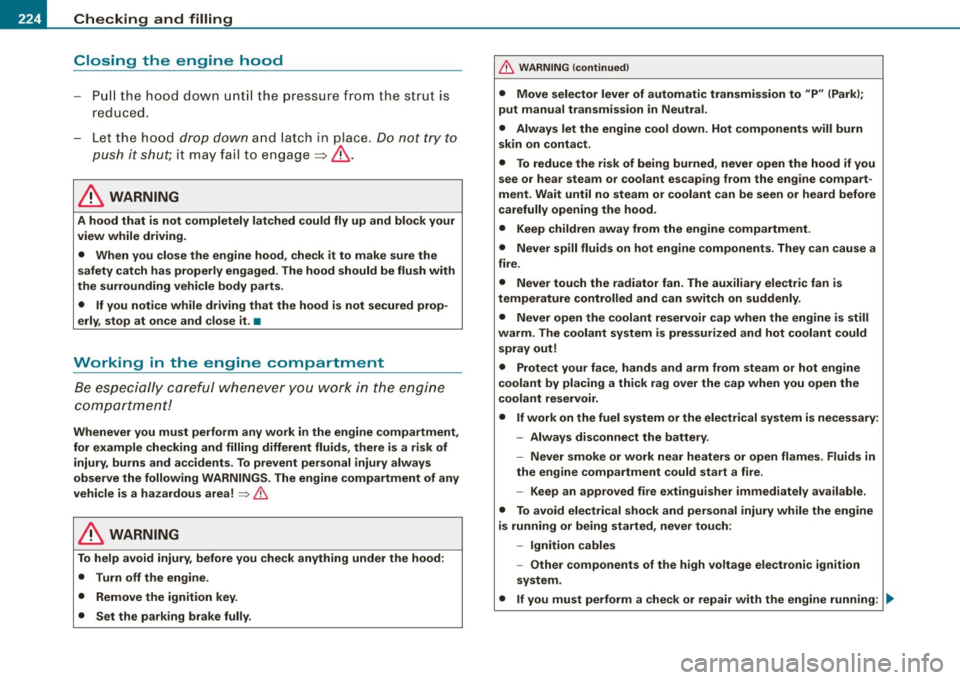
-~_C_ h_e _c _ k_ i_n ...:::g::;...._ a_n_ d_ f_ i_ll _in -'g:::;.._ ___________________________________________ _
Closing the engine hood
- Pull the hood down until the pressure from the strut is
reduced.
- Let the hood
drop down and latch in place. Do not try to
push it shut;
it may fail to engage~& .
& WARNING
A hood that is not completely latched could fly up and block your
view while driving.
• When you close the engine hood, check it to make sure the
safety catch has properly engaged. The hood should be flush with
the surrounding vehicle body parts.
• If you notice while driving that the hood is not secured prop
erly, stop at once and close it. •
Working in the engine compartment
Be especially careful whenever you work in the engine
compartment!
Whenever you must perform any work in the engine compartment,
for example checking and filling different fluids, there is a risk of injury, burns and accidents. To prevent personal injury always
observe the following WARNINGS. The engine compartment of any
vehicle is a hazardous area!
=> &
& WARNING
To help avoid injury, before you check anything under the hood :
• Turn off the engine.
• Remove the ignition key.
• Set the parking brake fully .
& WARNING (continued)
• Move selector lever of automatic transmission to "P" {Park);
put manual transmission in Neutral.
• Always let the engine cool down. Hot components will burn
skin on contact.
• To reduce the risk of being burned, never open the hood if you
see or hear steam or coolant escaping from the engine compart
ment. Wait until no steam or coolant can be seen or heard before
carefully opening the hood .
• Keep children away from the engine compartment.
• Never spill fluids on hot engine components. They can cause a
fire.
• Never touch the radiator fan. The auxiliary electric fan is
temperature controlled and can switch on suddenly.
• Never open the coolant reservoir cap when the engine is still
warm. The coolant system is pressurized and hot coolant could
spray out!
• Protect your face, hands and arm from steam or hot engine
coolant by placing a thick rag over the cap when you open the
coolant reservoir.
• If work on the fuel system or the electrical system is necessary:
- Always disconnect the battery .
- Never smoke or work near heaters or open flames. Fluids in
the engine compartment could start a fire.
- Keep an approved fire extinguisher immediately available.
• To avoid electrical shock and personal injury while the engine
is running or being started, never touch :
- Ignition cables
- Other components of the high voltage electronic ignition
system.
• If you must perform a check or repair with the engine running: .,_
Page 227 of 320
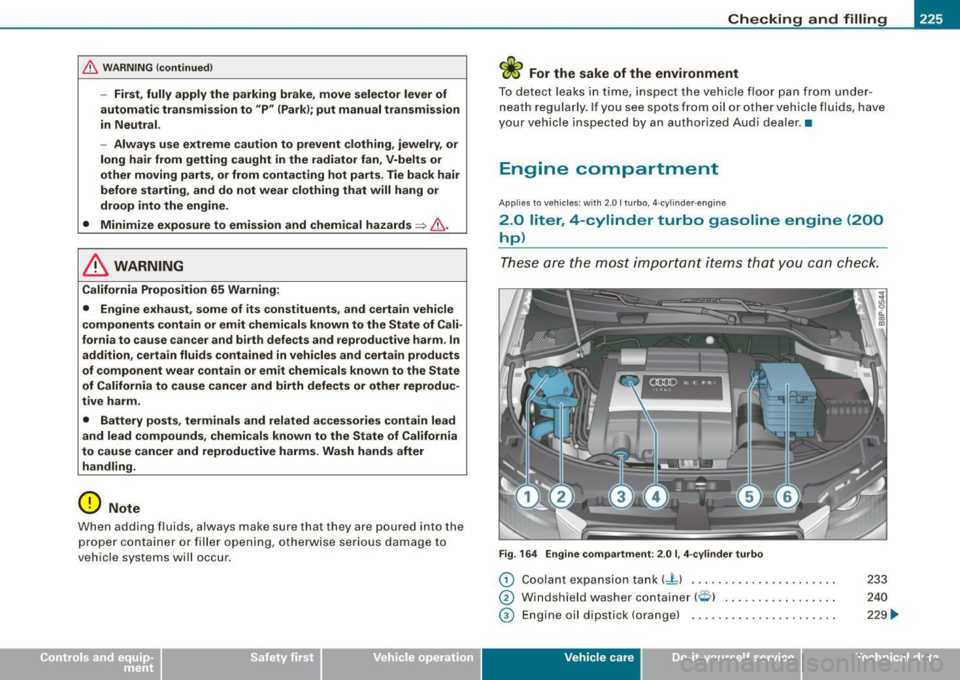
_____________________________________________ C_h_ e;::..:. c:..:..k :..:..in ;..:..= g:.....:.; a:..:..n :....:d :..:....:. f.:.:il .:.:li :..:..n :.::g:!-_ ___,JIJIII
& WARNING !continued )
-First, fully apply the parking brake, move selector lever of
automatic transmission to "P" (Park); put manual transmission
in Neutral.
- Always use extreme caution to prevent clothing, jewelry, or
long hair from getting caught in the radiator fan, V-belts or
other moving parts, or from contacting hot parts. Tie back hair
before starting, and do not wear clothing that will hang or
droop into the engine .
• Minimize exposure to emission and chemical hazards
:=> &.
& WARNING
California Proposition 65 Warning :
• Engine exhaust , some of its constituents, and certain vehicle
components contain or emit chemicals known to the State of Cali
fornia to cause cancer and birth defects and reproductive harm . In
addition, certain fluids contained in vehicles and certain products
of component wear contain or emit chemicals known to the State
of California to cause cancer and birth defects or other reproduc
tive harm.
• Battery posts, terminals and related accessories contain lead
and lead compounds , chemicals known to the State of California
to cause cancer and reproductive harms. Wash hands after
handling.
0 Note
When adding fluids , always make sure that they are poured into the
proper container o r filler opening, otherwise serious damage to
vehicle systems will occur .
ffi For the sake of the environment
To detect leaks in time, inspect the vehicle floor pan from under
neath regularly. If you see spots from oil or other vehicle fluids, have
your vehicle inspected by an authorized Audi dealer .•
Engine compartment
Ap plie s to veh icl es: wit h 2.0 I tur bo, 4-cy lind er•e ng ine
2.0 liter , 4-cylinder turbo gasoline engine (200
hp)
These are the most important items that you can check.
Fig. 164 Engine compartment : 2 .0 I , 4-cy linder turbo
G) Coolan t expansion tank (- L l .... ... .... .... ... .. . .
0 Windshield washer container (W ) ... .... ... ... ... .
© Eng ine oil d ipstick (orange) .. ...... ........ ..... .
Vehic le care I I
233
240
229 ~
irechnical data
Page 228 of 320
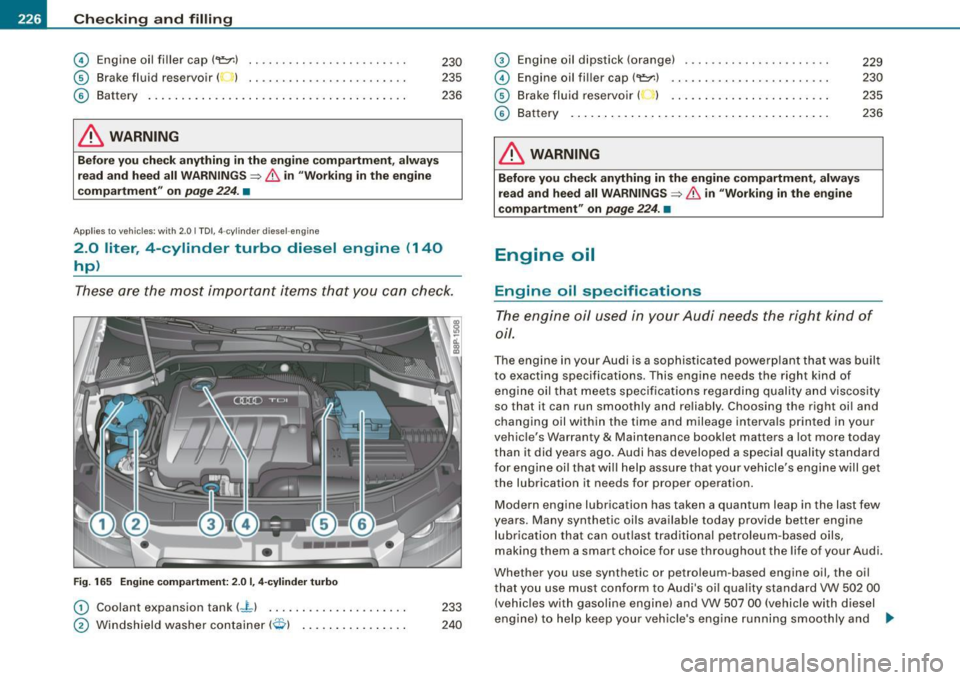
___ C_h_ e_ c_k _in --== g'-- a_n _d_ f_il _li _n ..:::g:::..- ___________________________________________ _
© Engine oil filler cap ("t=:?:) .... ........ .... ... ... . .
© Brake fluid reservoir ( l .......... ... .. ...... .. .
© Battery ...... .. ........ ....... ......... .. .... .
& WARNING
Before you check anything in the engine compartment , always
read and heed all WARNINGS ~
& in "Working in the engine
compartment" on
page 224. •
Applies to veh icles : with 2.0 I TO I, 4-cyl inder diese l-engine
230
235
236
2 .0 liter , 4-cylinder turbo diesel engine (140
hp)
These are the most important items that you can check.
Fig. 165 Engine compartment: 2.0 I, 4-cylinder turbo
G) Coolant expansion tank ( J_ ) ....... ... .... .... .. .
0 Windshield washer container ('C,;> ) •••• •• •••• ••• •• •
233
240
© Engine oil dipstick (orange) ..... ... ...... .... ... .
© Engine oil filler cap ("t=:?:) .. ...... ..•........... ..
G) Brake fluid reservoir ( ) ..... ....... ...... .... . .
© Battery . .................. ..... .............. .
& WARNING
Before you check anything in the engine compartment, always
read and heed all WARNINGS
~ & in "Working in the engine
compartment" on
page 224. •
Engine oil
Engine oil specifications
229
230
235
236
The engine oil used in your Audi needs the right kind of
oil.
The engine in your Audi is a sophisticated powerp lant that was built
to exacting specifications. This engine needs the right kind of
engine oil that meets specifications rega rding quality and viscosity
so that it can run smoothly and reliably. Choosing the right oil and
changing oil within the time and mileage intervals printed in your
vehic le's Warranty
& Maintenance booklet matters a lot more today
than it did years ago. Audi has developed a special quality standard
for engine oi l that will help assure that your vehicle's engine will get
the lubrication it needs for proper operation.
Modern engine lubrication has taken a quantum leap in the last few
years. Many synthetic oils available today provide better engine
lubrication that can outlast traditional petroleum -based oils,
making them a smart choice for use throughout the life of your Audi.
Whether you use synthetic or petroleum -based engine oil, the oil
that you use must conform to Audi's oi l quality standard VW 502 00
(vehicles with gasoline engine) and VW 507 00 (vehicle with diesel
engine) to help keep your vehicle's engine running smoo thly and _,..
Page 229 of 320
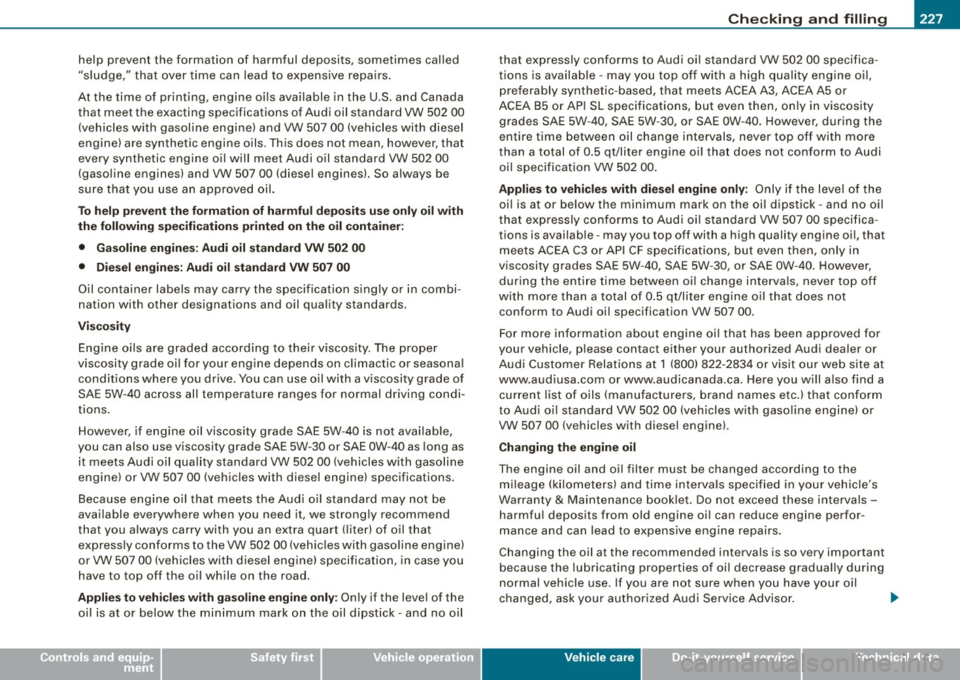
___________________________________________ C_ h_e _c_ k_ i_n _g _ a_n _d_ f_il _li _n _g __ fflllll
•
help prevent the formation of harmful deposits, sometimes called
"s ludge," that over time can lead to expensive repairs.
At the time of printing, engine oi ls available in the U .S . and Canada
that meet the exacting specifications of Audi oil standard VW 502 00
(vehicles with gasoline engine) and VW 507 00 (vehicles with diesel
engine) are synthetic engine oils. This does not mean, however, that
every synthe tic engine oil wi ll meet Audi o il standard VW 502 00
(gasoline engines) and VW 507 00 (diesel engines). So always be
sure that you use an approved oil.
To help p reve nt th e for matio n of ha rmful d epo sit s use only oil wit h
the following sp ecific ati ons print ed on th e oil contain er:
• Gas oline engine s: Audi oil sta ndard VW 502 00
• Dies el en gin es: Aud i oil stand ard VW 507 00
O il container labels may carry the speci fication singly or in combi
nation with other designations and oil qua lity standards.
Vi sc osity
Engine o ils are graded according to their viscosity. The proper
viscosity grade oil for your engine depends on climactic or seasona l
conditions where you drive . You can use o il with a v iscosity grade o f
SAE 5W-40 across all temperature ranges for normal driving condi
tions.
However, if engine oil viscosity grade SAE 5W-40 is not avai lab le,
you can also use viscosity grade SAE 5W -30 or SAE 0W -40 as long as
it meets Audi oil quality standard VW 502 00 (vehicles with gaso line
engine) or VW 507 00 (vehicles with diesel engine) specifications.
Because engine oil that meets the Aud i o il standard may not be
avai lable everywhere when you need it, we strong ly recommend
that you a lways carry with you an extra quart (liter) of oil that
expressly conforms to the VW 502 00 (vehic les with gaso line engine)
or VW 507 00 (vehicles with diesel engine) specification, in case you
have to top off the oil while on the road.
Ap plie s to veh icles with g asoline eng ine onl y: Only if the level of the
oi l is at or below the min imum mark on the oil dipstick -and no oil that expressly conforms to Audi oi
l standard VW 502 00 specifica
tions is availab le -may you top off with a high quality e ngine oi l,
preferably synthetic-based, that meets ACEA A3, ACEA A5 or
ACEA 85 or AP I SL specifications, but even then, on ly in viscos ity
grades SAE 5W-40, SAE 5W -30, or SAE 0W-40. However, during the
entire time between oil change intervals, never top off with more
than a total of 0.5 qt/liter engine oil that does not con form to Audi
oi l specification VW 502 00 .
Applies to veh icle s with die sel eng ine only: Only if the level of the
oi l is at or below the minimum mark on the oi l dipstick -and no oil
that expressly confo rms to Aud i oi l standard VW 507 00 specifica
tions is available -may you top off with a high quality engine oil, that
meets ACEA C3 or API CF specifications, but even then, only in
v iscosity grades SAE 5W -40, SAE 5W -30 , or SAE 0W-40. However,
during the entire time between oi l change interva ls, never top off
with more than a total of 0.5 qt/liter engine oil that does not conform to Audi oil specification VW 507 00.
For more information abo ut engine oi l that has been app roved for
your vehicle, p lease contact either your authorized Audi dea ler or
Audi Custo mer Relations at 1 (800) 822 -2834 or visit our web site at
www.audiusa.com or www.audicanada.ca . Here you will a lso find a
current list of oils (manufacturers, brand names etc.) that conform
to Audi oi l standard VW 502 00 (vehicles with gaso line engine) or
VW 507 00 (vehicles with diese l engine) .
Changin g the engine oil
The engine oil and oil filter must be changed according to the
mi leage (ki lometers) and time in tervals specified in your vehic le's
Warranty
& Maintenance book let. Do not exceed these intervals -
harmful deposits from old engine oil can reduce engine perfor
mance and can lead to expensive engine repairs.
Changing the oil at the recommended intervals is so very important
because the lub ricating prope rties of oi l decrease gradua lly during
normal vehicle use . If you are not sure when you have your oil
changed, ask your authorized Audi Service Advisor . ..,.
Vehicle care I t •
Page 230 of 320
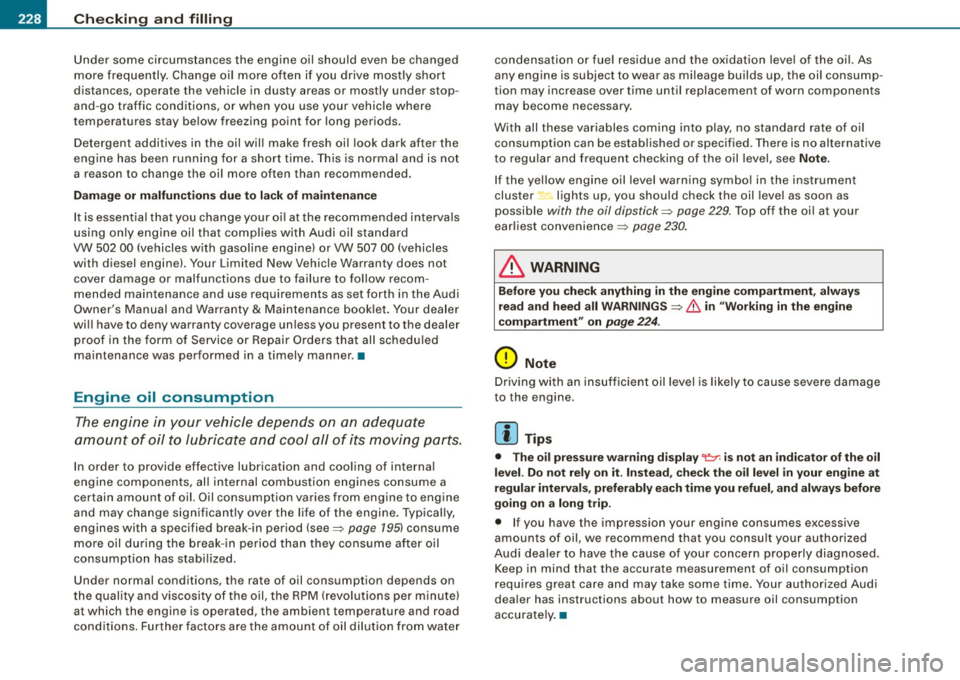
-~_C_ h_e _c _ k_ i_n ...:::g::;...._ a_n_ d_ f_ i_ll _in -'g:::;.._ ___________________________________________ _
Under some circumstances the engine oil should even be changed
more frequently. Change oil more often if you drive mostly short
distances, operate the vehicle in dusty areas or mostly under stop
and -go traffic conditions, or when you use your vehicle where
temperatures stay below freezing point for long periods .
Detergent additives in the oil will make fresh oil look dark after the
engine has been running for a short time. This is normal and is not
a reason to change the oil more often than recommended .
Damage or malfunctions due to lack of maintenance
It is essential that you change your oi l at the recommended intervals
using only engine oil that complies with Audi oil standard
VW 502 00 (vehicles with gasoline engine) or VW 507 00 (vehicles
with diesel engine). Your Limited New Vehicle Warranty does not
cover damage or malfunctions due to failure to follow recom
mended maintenance and use requirements as set forth in the Audi
Owner's Manual and Warranty
& Maintenance booklet. Your dealer
will have to deny warranty coverage unless you present to the dealer proof in the form of Service or Repair Orders that all scheduled
maintenance was performed in a timely manner .•
Engine oil consumption
The engine in your vehicle depends on an adequate
amount of oil to lubricate and cool all of its moving parts.
In order to provide effective lubrication and cooling of interna l
engine components, all internal combustion engines consume a
certain amount of oil. Oil consumption varies from engine to engine
and may change significant ly over the life of the engine. Typically,
engines with a specified break -in period (see=>
page 195) consume
more oil during the break-in period than they consume after oil
consumption has stabilized.
Under normal conditions, the rate of oil consumption depends on
the quality and viscosity of the oil, the RPM (revolutions per minute)
at which the engine is operated, the ambient temperature and road
conditions. Further factors are the amount of oil dilution from water condensation or fuel residue and the oxidation level of the oil. As
any
engine is subject to wear as mileage builds up, the oil consump
tion may increase over time until replacement of worn components
may become necessary .
With all these variables coming into play, no standard rate of oi l
consumption can be established or specified. There is no alternative
to regular and frequent checking of the oil level, see
Note.
If the yellow engine oil level warning symbol in the instrument
cluster lights up, you should check the oil level as soon as
possible
with the oil dipstick=> page 229. Top off the oi l at your
earliest convenience =>
page 230.
& WARNING
Before you check anything in the engine compartment, always
read and heed all WARNINGS
=> &. in "Work ing in the engine
compartment" on
page 224.
0 Note
Driving with an insufficient oil level is likely to cause severe damage
to the engine.
[ i ] Tips
• The oil pressure warning display~ is not an indicator of the oil
level. Do not rely on it. Instead, check the oil level in your engine at
regular intervals , preferably each time you refuel, and always before
going on a long trip.
• If you have the impression your engine consumes excessive
amounts of oil, we recommend that you consu lt your authorized
Audi dealer to have the cause of your concern properly diagnosed .
Keep in mind that the accurate measurement of oil consumption
requires great care and may take some time. Your authorized Audi
dealer has instructions about how to measure oil consumption
accurately. •